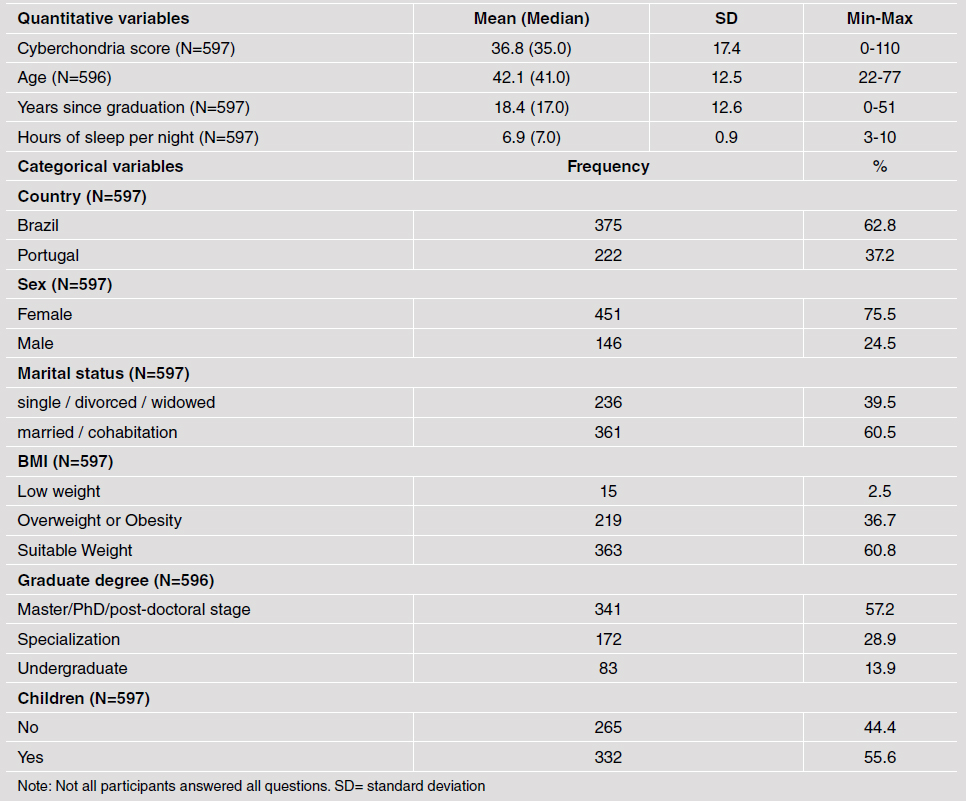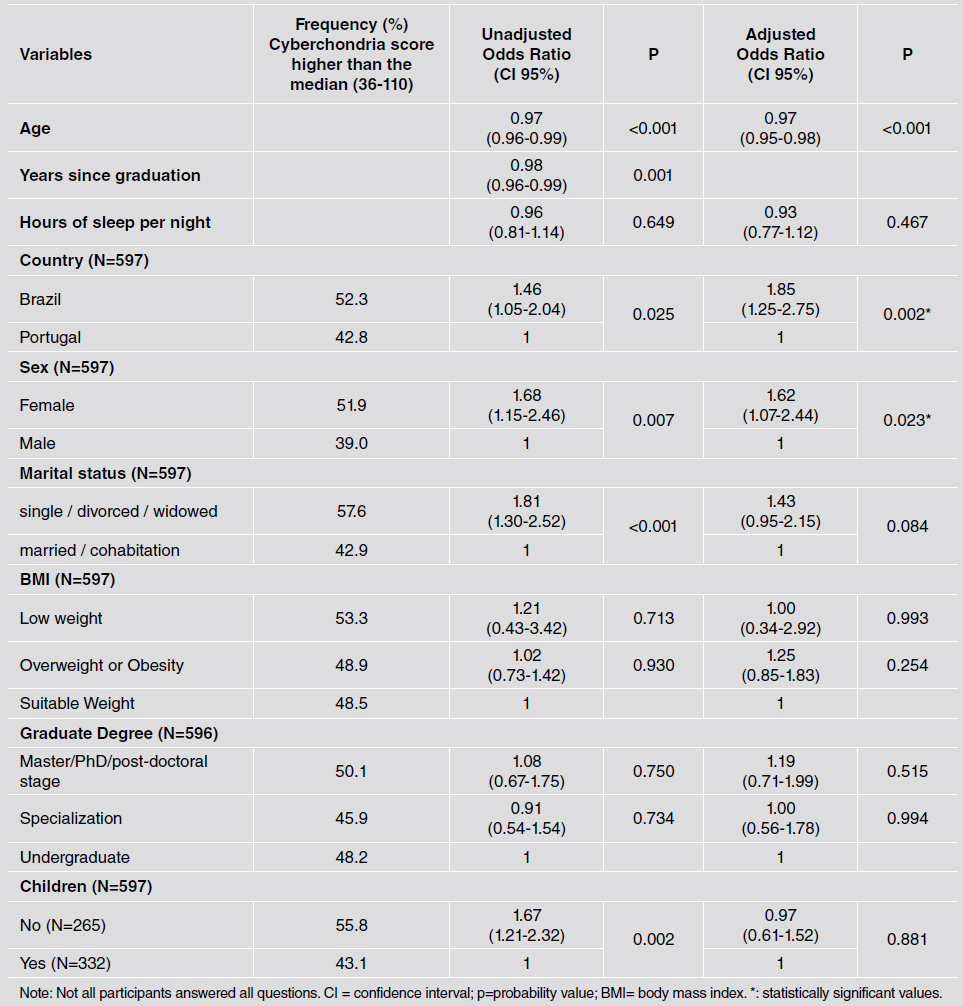INTRODUCTION
The term “Cyberchondria” was coined by joining the words cyber and hypochondria to characterize a psychopathological behavior, a somatoform disorder, now also called digital hypochondria. A cyberchondriac is a person who performs repeated internet searches for health information, which are associated with increasing levels of health anxiety 1 . The impact of internet on access to health information has increased over time 2 , and although finding information on the characteristics, prevention and self-care of illnesses has enabled people to improve their health outcomes 3 , it should be noted that internet can provide access to both trustworthy and untrustworthy content 2 . Cyberchondria entails excessive online searches to seek reassurance about the nonthreatening nature of the self-perceived signs and symptoms. This condition has been associated with obsessive-compulsive disorders, hypochondriasis, and health anxiety, and can be a risk factor for the development of more mental illness 4 . People with cyberchondria have heightened anxiety, often because of new pathologies that they have discovered online, and this generates new concerns that are amplified in the mind of the cyberchondriac. Anxiety disorders can lead to discomfort, accelerated heartbeat, cold sweat and poor sleep quality 5 .
Cyberchondria has been studied since 2000 1 . Since then, professionals have sought to analyze this behavior that can be adopted by anyone, including students of health sciences. Students of medicine, nursing, dentistry, and other health sciences may incorrectly believe that they have contracted certain diseases they have studied 6 . This can also be observed in the form of anxiety. Health anxiety, cyberchondria and sociodemographic factors may show specific behavior patterns among students of health sciences. Medical students in Turkey had high scores of health anxiety and men were more suspicious of doctors, seeking information on the internet prior to going for medical consultations 6 . This mistrustfol behavior can compromise the promotion of physical and emotional health 6 . A study on Indian computer technicians found a prevalence of 55.6% of high level of cyberchondria 7 , and the authors emphasized that this high prevalence deserved preventive care. Cyberchondria compromises mental health, so finding ways to prevent it can help promote public health 7 .
In view of the relevance and scarcity of data about the topic in the field of dentistry, the aim of this study was to assess the level of cyberchondria and factors associated with it among Brazilian and Portuguese dentists.
MATERIALS AND METHODS
Ethical Aspects
This study was conducted in compliance with the principles of the Declaration of Helsinki (revised in World Medical Association 2013), and approved by the Human Research Ethics Committee of the Federal University of Minas Gerais (Brazil) (Protocol #91561018.5.0000.5149).
Design, Population, and Study Sample This study included Brazilian and Portuguese dentists who consented to answer an online questionnaire posted on the Google Forms platform from January 17 to 31, 2021. Subjects were invited to participate by means of a link disseminated via WhatsApp, Facebook Messenger, and online forums for Dentists. Dentists were contacted through both Brazilian and Portuguese dental class societies.
The questionnaire was structured into two sections: one for collecting sociodemographic information, and another to measure cyberchondria using the Portuguese language version of the Cyberchondria Severity Scale (CSS) 8 . The original CSS was developed by Irish psychologists with undergraduate students 9 .
To participate in the study, each participant was asked to complete and sign a free and informed consent form. Only dentists were included. The exclusion criterion was anyone who was not a dentist from Portugal or Brazil. Each participant received his/her personal score for the CSS.
Data Collection and Variables Participants answered a questionnaire with 40 closed questions. The questionnaire included seven questions to collect participants’ demographic information.
The CSS includes 33 statements that allow each participant to define his/her typical behavior, using a five-point scale: Never; Rarely; Sometimes; Frequently; Always 8 . The total score ranged from zero to 132 points. The higher the score, the higher the level of cyberchondria 8 .
Pilot Study
A pilot study to evaluate the proposed methodology was conducted on 21 dentists. The results of the pilot study demonstrated that there was no need to modify the proposed methods of the main study. Pilot study participants were not included in the main study.
Statistical Analysis
Descriptive data analysis was performed with the calculation of proportions, central tendency and variability measures. The dependent variable was the Cyberchondria score, which ranged from 0 to 132. The score was categorized by the median, into low level of Cyberchondria (0-35), and high level of Cyberchondria (36-132).
Binary logistic regression models were used to estimate the unadjusted and adjusted Odds Ratio (OR) and corresponding 95% Confidence Interval (CI) for the association of Cyberchondria and covariates. Each covariate was individually included in the regression model, and the unadjusted OR (95% CI) was estimated. All covariates were simultaneously included in the final binary logistic model, in which only variables with P values lower than 0.05 remained significan! Linearity of logit of quantitative variables was also checked. Collinearity diagnosis was made by the Variation Inflation Factor. The Hosmer & Lemeshow test was used to check the goodness of fit of the final model. All statistical analysis was performed using SPSS software for Windows version 26.0 (SPSS Inc., Chicago, IL, USA).
RESULTS
A total 597 dentists participated in this study, of whom 62.8% were Brazilian, and 37.2%, Portuguese. The majority had graduate degrees (57.2%), were women (75.5%), married (60.5%) and had children (55.6%). Age ranged from 22 to 77 years, with mean age 42.1 (+12.5) (Table 1). The power of the sample
The final model showed that for each one-year increase in age, the chance of high level of cyberchondria decreased (OR = 0.97; 95% CI 0.95-0.98). Brazilian dentists were 1.85 (95% CI 1.25-2.75) times more likely to have a high level of cyberchondria than Portuguese dentists. Women had 1.62 (95% CI 1.07-2.44) times greater chance of high level of cyberchondria than men. When evaluating multicollinearity, the variable ‘’graduated a given number of years ago” was removed from the final model VIF> 10 (Table 2). After this removal, there were no further collinearity problems in the final model. The assumption of linearity of the logarithm for the age variable was not violated. The assessment of influential cases by Cook’s distance did not reveal values higher than one, indicating the absence of influential cases. The final model was ate according to the assessment made by the Hosmer & Lemeshow test (p = 0.498).
DISCUSSION
The aim of this study was to assess the level of cyberchondria, and factors associated with it, among Brazilian and Portuguese dentists. Our results demonstrated that a high level of cyberchondria was more prevalent among women, among younger ages and among Brazilian dentists. These results will be discussed below.
The study of cyberchondria is still very recent. There are controversies about gender and age differences 10 . Our findings showed a higher level of cyberchondria among women, which was in agreement with the findings of Atikinson et al. (2009) 11 . However, other studies have found no differences between the genders 11-14 . These differences in results may be justified by the cultural differences in the studies mentioned.
A systematic review found that women tended to use the internet more frequently than men 15 . On the internet, the behavior between genders differs, as women tend to seek more information on health and social networking sites while men tended to consult video. Furthermore, women tend to be more anxious than men 16 . Studies have suggested that anxious people spend more time on the Internet 11-14 . With the already present fear of contracting numerous diseases, anxious people become even more concerned about their health as a result of online medical searches, and this is characteristic of cyberchondriacs 12 . People with a high level of anxiety are more likely to exaggerate the perception of signs and symptoms of their own or those of loved ones 11 . The more emotionally overwhelmed someone feels, the more the person tends to spend time looking for the specific symptom, and the more they search for disease symptoms, the more they convinced are that they are ill 13 .
Internet use was found to decrease as age increased 17 . Young people are more familiar than the elderly with websites, software and social networks 1, 17 , and consequently, there are more younger than older cyberchondriacs, as seen in our findings. This result was in line with those reported by McMullan et al. 1 . The number of internet users in the world has increased in recent decades. In 2021, to date, there are 145.83 million internet users in Brazil and 7.7 million in Portugal. Brazil is the larger country, with a surface area of 8.516.000 sq km and population 211 million, while Portugal has a surface area of 92.212 sq km and population 10 million 18 . The proportion of internet users in both countries is similar, at 70%. The territorial and housing differences therefore do not explain the greater number of cyberchondriacs in Brazil than in Portugal. Our findings therefore suggest a cultural difference.
It is also important to emphasize that data were collected during the COVID-19 pandemic. Social distancing was in place in both countries at the time of data collection. However, Brazil was experiencing an uncontrolled situation of disease, with an average 3000 deaths every 24 hours. Portugal had already started the vaccination campaign against COVID-19, while Brazil had not. This increases anxiety and can influence the behavior of cyberchondriacs 2, 10 . Limitations were noted in this study. The cross-sectional design allows analysis of association and does not allow analysis of cause and effect. Future studies with other longitudinal and qualitative designs should be encouraged. The sample, made up of dentists, limits the extrapolation of results to other communities and other professionals. The study of cyberchondria is still very recent and there are few studies with which to compare results, which would lead to a more in-depth discussion 19 . Our findings highlight the importance of educational campaigns on cyberchondria. Dentists are important health promoters 20 and should be encouraged to take care of their own physical and mental health.
















